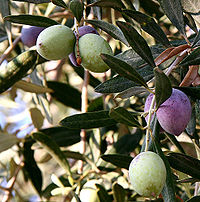
Photo from wikipedia
AbstractMain conclusionThe use of a VIGS approach to silence the newly characterized apple tree SQS isoforms points out the biological function of phytosterols in plastid pigmentation and leaf development. Triterpenoids… Click to show full abstract
AbstractMain conclusionThe use of a VIGS approach to silence the newly characterized apple tree SQS isoforms points out the biological function of phytosterols in plastid pigmentation and leaf development. Triterpenoids are beneficial health compounds highly accumulated in apple; however, their metabolic regulation is poorly understood. Squalene synthase (SQS) is a key branch point enzyme involved in both phytosterol and triterpene biosynthesis. In this study, two SQS isoforms were identified in apple tree genome. Both isoforms are located at the endoplasmic reticulum surface and were demonstrated to be functional SQS enzymes using an in vitro activity assay. MdSQS1 and MdSQS2 display specificities in their expression profiles with respect to plant organs and environmental constraints. This indicates a possible preferential involvement of each isoform in phytosterol and/or triterpene metabolic pathways as further argued using RNAseq meta-transcriptomic analyses. Finally, a virus-induced gene silencing (VIGS) approach was used to silence MdSQS1 and MdSQS2. The concomitant down-regulation of both MdSQS isoforms strongly affected phytosterol synthesis without alteration in triterpene accumulation, since triterpene-specific oxidosqualene synthases were found to be up-regulated to compensate metabolic flux reduction. Phytosterol deficiencies in silenced plants clearly disturbed chloroplast pigmentation and led to abnormal development impacting leaf division rather than elongation or differentiation. In conclusion, beyond the characterization of two SQS isoforms in apple tree, this work brings clues for a specific involvement of each isoform in phytosterol and triterpene pathways and emphasizes the biological function of phytosterols in development and chloroplast integrity. Our report also opens the door to metabolism studies in Malus domestica using the apple latent spherical virus-based VIGS method.
Journal Title: Planta
Year Published: 2017
Link to full text (if available)
Share on Social Media: Sign Up to like & get
recommendations!